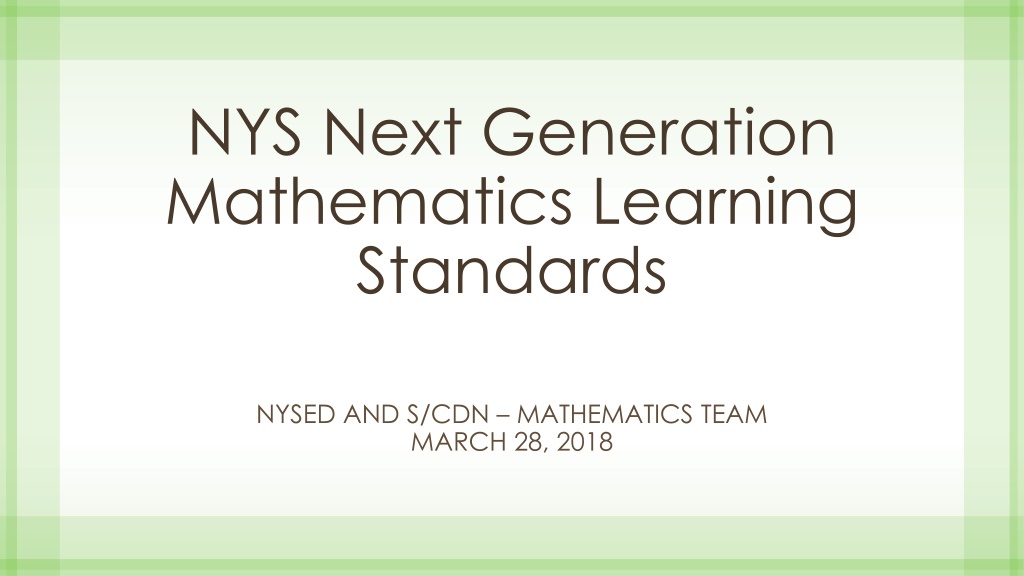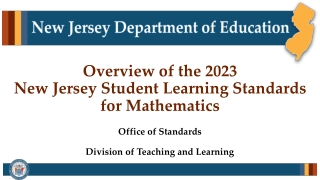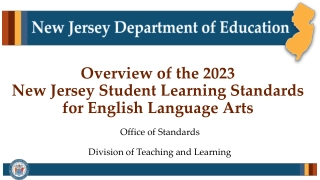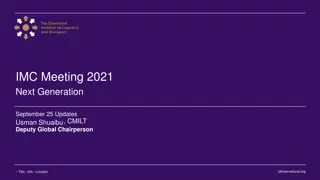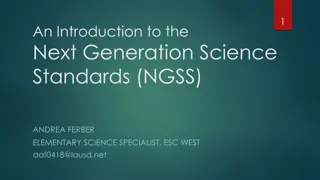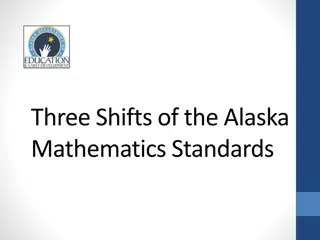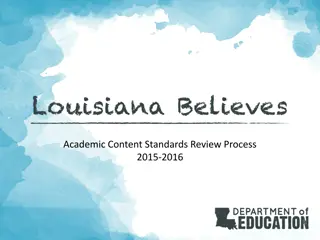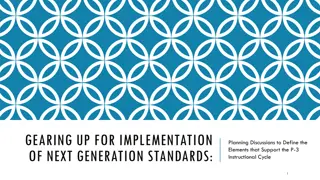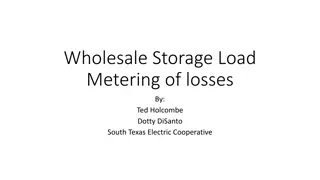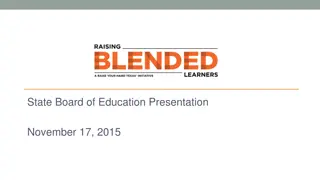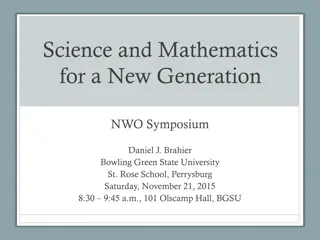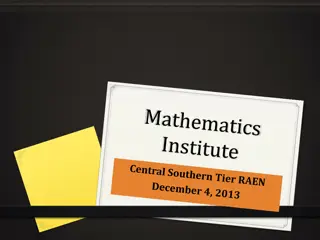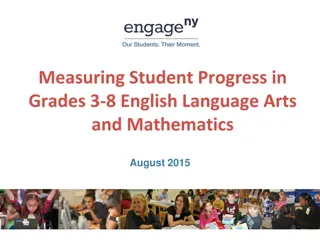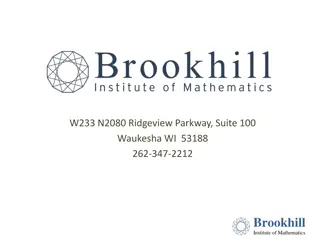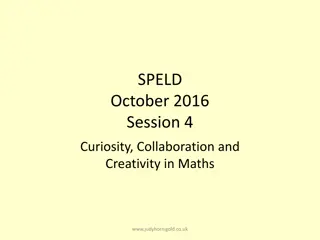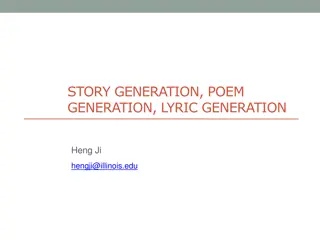New York State Next Generation Mathematics Learning Standards Overview
New York State (NYS) embarked on a comprehensive review and revision of its mathematics standards starting in 2015. This process involved input from various stakeholders such as educators, parents, and experts, resulting in the development of the New York State Next Generation Mathematics Learning Standards in 2017. The standards were designed to be more inclusive and reflective of diverse learner populations, emphasizing the importance of aligning content standards with mathematical practices. The revision was driven by a survey conducted by NYSED to gather feedback from over 10,500 participants, leading to more than 750,000 pieces of valuable input.
Download Presentation

Please find below an Image/Link to download the presentation.
The content on the website is provided AS IS for your information and personal use only. It may not be sold, licensed, or shared on other websites without obtaining consent from the author. Download presentation by click this link. If you encounter any issues during the download, it is possible that the publisher has removed the file from their server.
E N D
Presentation Transcript
NYS Next Generation Mathematics Learning Standards NYSED AND S/CDN MATHEMATICS TEAM MARCH 28, 2018
www.nysed.gov/next-generation-learning-standards https://www.engageny.org/next-generation-learning-standards
The Introduction: Why Start Here ? Why is there a need for change ? What is the relationship between standards, curriculum, instruction and assessment with regards to student learning ? How do we make the standards accessible to our diverse learner populations ? What is the importance of connecting the Content Standards to the Standards for Mathematical Practice, and what does this look like ?
The Opening Paragraph In 2015, New York State (NYS) began a process of review and revision of its current mathematics standards adopted in January of 2011. Through numerous phases of public comment, virtual and face-to-face meetings with committees consisting of NYS educators (Special Education, Bilingual Education and English as a New Language teachers), parents, curriculum specialists, school administrators, college professors, and experts in cognitive research, the New York State Next Generation Mathematics Learning Standards (2017) were developed. These revised standards reflect the collaborative efforts and expertise of all constituents involved.
2015 Legislative Requirement: Standards re-evaluated with stakeholder input NYSED conducted a survey (AIMHighNY) of teachers, parents and other stakeholders about the current standards. More than 10,500 people responded to the survey and provided over 750,000 pieces of feedback Fall 2015
2015 Legislative Requirement: Standards re-evaluated with stakeholder input NYSED conducted a survey (AIMHighNY) of teachers, parents and other stakeholders about the current standards. More than 10,500 people responded to the survey and provided over 750,000 pieces of feedback state that met for a week in Albany during July NYSED formed the Mathematics Learning Standards Review committee comprised of more than 68 educators and key stakeholders across the Fall 2015 April 2016
Standards Review Committee The Math and ELA Leadership Teams plan the logistics for the standards review process including developing materials and providing guidance for the Standards Review Committees. NYC DOE BOCES/SCDN Standards Review Leadership Team NYSUT NYSED Grade Band Committees Facilitator: Content Advisory Member Both Math and ELA Committees are split into grade band subcommittees; and into course subcommittees for high school math. Teachers: P-12, ENL, Special Education Administrators: Building level, District level, Instructional Coaches College Professors: SUNY, CUNY, Community Colleges Parents: Urban, Suburban, rural, ENL, SWD 12
2015 Legislative Requirement: Standards re-evaluated with stakeholder input NYSED formed the Mathematics Learning Standards Review committee comprised of more than 70 educators and key stakeholders across the state that met for a week in Albany during July NYSED released the new draft learning standards for public comment and received more than 4,100 comments April 2016 Fall 2015 Sept. 2016
2015 Legislative Requirement: Standards re-evaluated with stakeholder input The Mathematics Content Advisory Panel and other committees reviewed every learning standard, making any necessary modifications based on NYSED released the new draft learning standards for public comment and received more than 4,100 comments professional expertise as well as input gathered from public comment and child development experts Fall 2015 April 2016 Sept. 2016 Dec. 2016 April 2017
2015 Legislative Requirement: Standards re-evaluated with stakeholder input The Mathematics Content Advisory Panel and other committees reviewed every learning standard, making any necessary modifications based on professional expertise as well as input gathered from public comment and child development experts Revised learning standards presented to the Board of Regents May 2017 Sept. 2016 Fall 2015 April 2016 Dec. 2016 April 2017
2015 Legislative Requirement: Standards re-evaluated with stakeholder input Next Generation Mathematics Learning Standards approved by the Board Revised learning standards presented to the Board of Regents of Regents Sept. 2016 Fall 2015 April 2016 May 2017 Sept. 2017 Dec. 2016 April 2017
The New York State Next Generation Mathematics Learning Standards (2017) reflect revisions, additions, vertical movement, and clarifications to the current mathematics standards. The Standards are defined as the knowledge, skills and understanding that individuals can and do habitually demonstrate over time because of instruction and learning experiences. Standards
These mathematics standards, collectively, are focused and cohesive designed to support student access to the knowledge and understanding of the mathematical concepts that are necessary to function in a world very dependent upon the application of mathematics, while providing educators the opportunity to devise innovative programs to support this endeavor.. Instruction Curriculum
As with any set of standards, they need to be rigorous; they need to demand a balance of conceptual understanding, procedural fluency and application and represent a significant level of achievement in mathematics that will enable students to successfully transition to post- secondary education and the workforce. Assessment
Standards Instruction How do these four components work together to support student learning? Curriculum Assessment
Context for Revision of the NYS Next Generation Mathematics Learning Standards (2017) Changing expectations for mathematics achievement Increasingly Diverse Learner Populations Students with Disabilities and the Standards Understanding the NYS Next Generation Mathematics Learning Standards (2017)
Round Robin Each team of 4 will be provided a set of task cards to read While reading your assigned task card, answer the following: What is the most important takeaway? How do you relate your takeaway to standards, curriculum, instruction, and/or assessment?
HIGH CEILING What types of learning experiences support these changing expectations? LOW FLOOR
Describe how the shapes are growing. Case 1 Case 2 Case 3
Continuous Round Table Pass your paper clockwise Read your teammates description Write at least 1 comment reflecting on their description Repeat process until you receive your paper back
Thats Me! Which method do you identify with? We ll share some common strategies. If you hear one of yours, stand up and say, That s me!
Team Collaboration What would the 6th case look like? How many total blocks would it have? How do you know? How many blocks would there be in the nth case? How do you know?
How Do The NYS Next Generation Mathematics Learning Standards Support These Changing Expectations? Connecting Content to Practice Standards for Mathematical Content NY-3.OA.9 NY-4.OA.5 NY-5.OA.3 NY-6.EE.1 NY-6.EE.2 NY-6.G.5 AI-F.BF.1a
How Do The NYS Next Generation Mathematics Learning Standards Support These Changing Expectations? Connecting Content to Practice Standards for Mathematical Practice Standards for Mathematical Standards for Mathematical Content Content & Practice What are the Standards for Mathematical Practice?
Standards for Mathematical Practice Make sense of problems and persevere in solving them 1. Reason abstractly and quantitatively 2. Construct viable arguments and critique the reasoning of others 3. Model with mathematics 4. Use appropriate tools strategically 5. Attend to precision 6. Look for and make use of structure 7. Look for and express regularity in repeated reasoning 8.
Table Talk Each table has been assigned a number At your table fill in the following sentence frame: SMP ________ Looked like _________ and Sounded like ____________ during this activity.
Work as an impactful and motivated data scientist developing technical solutions to complex problems. Analyze data to identify trends and support the development of mission-related analyses, using techniques such as econometrics regression analysis, cluster analysis, Bayesian analysis, discriminant analysis, sentiment analysis, support vector machines, survival analysis, and other modes of machine learning. Contribute to the development of new concepts and experiments, translate these ideas into executable action plans, and communicate these plans to a diverse client base. Create mathematical models and programs used to test solutions to complex systems. Work within cross-functional teams to engage the client, comprehend the client's problems, develop strategic analytical products, support requirements analysis, including process and systems analyses, support the development of business and system architectures, and define actionable system requirements. Source: https://www.clearancejobs.com/jobs/2618108/data-scientist-junior-in-washington-dc-at-booz-allen-hamilton
What do the Standards for Mathematical Practice Look and Sound Like in Kindergarten? https://www.teachingchannel.org/videos/pre-k-math-lesson
NYSED Office of Curriculum and Instruction 518-474-5922 John Svendsen (NYSED Math Associate) John.Svendsen@nysed.gov Sue Brockley (NYSED Math Associate) Susan.Brockley@nysed.gov Boards of Cooperative Educational Services (BOCES) Staff and Curriculum Development Network (S/CDN) NYSCDN.COM Whose mission is to strengthen the capacity of school districts to promote successful attainment of the New York State Standards by all students.
Standards Review Committee The Math and ELA Leadership Teams plan the logistics for the standards review process including developing materials and providing guidance for the Standards Review Committees. NYC DOE BOCES/SCDN Standards Review Leadership Team NYSUT NYSED Grade Band Committees Facilitator: Content Advisory Member Both Math and ELA Committees are split into grade band subcommittees; and into course subcommittees for high school math. Teachers: P-12, ENL, Special Education Administrators: Building level, District level, Instructional Coaches College Professors: SUNY, CUNY, Community Colleges Parents: Urban, Suburban, rural, ENL, SWD Back 40
